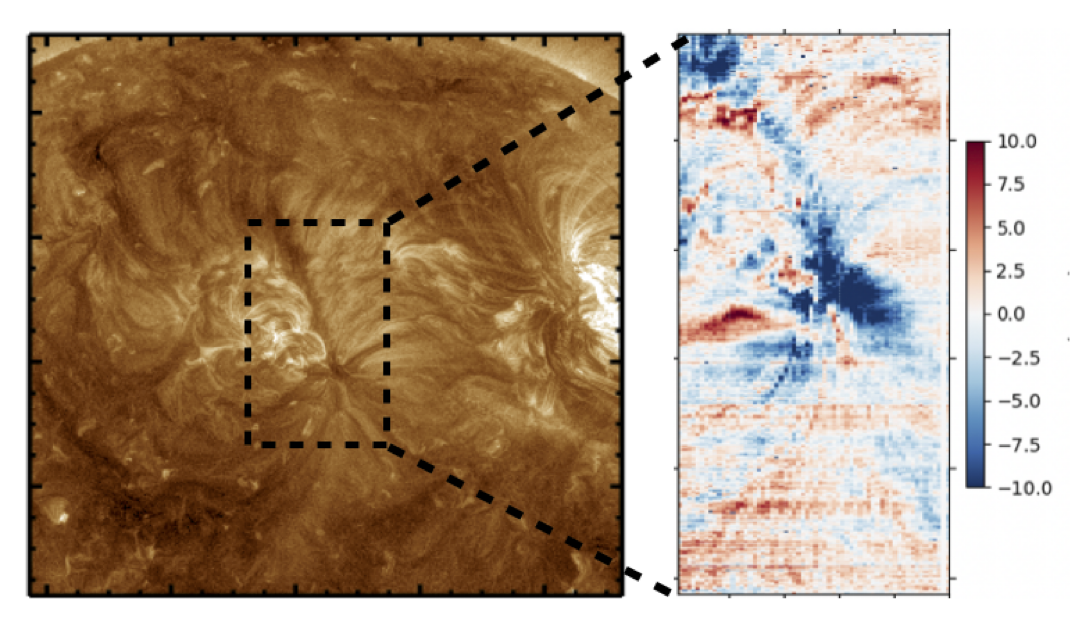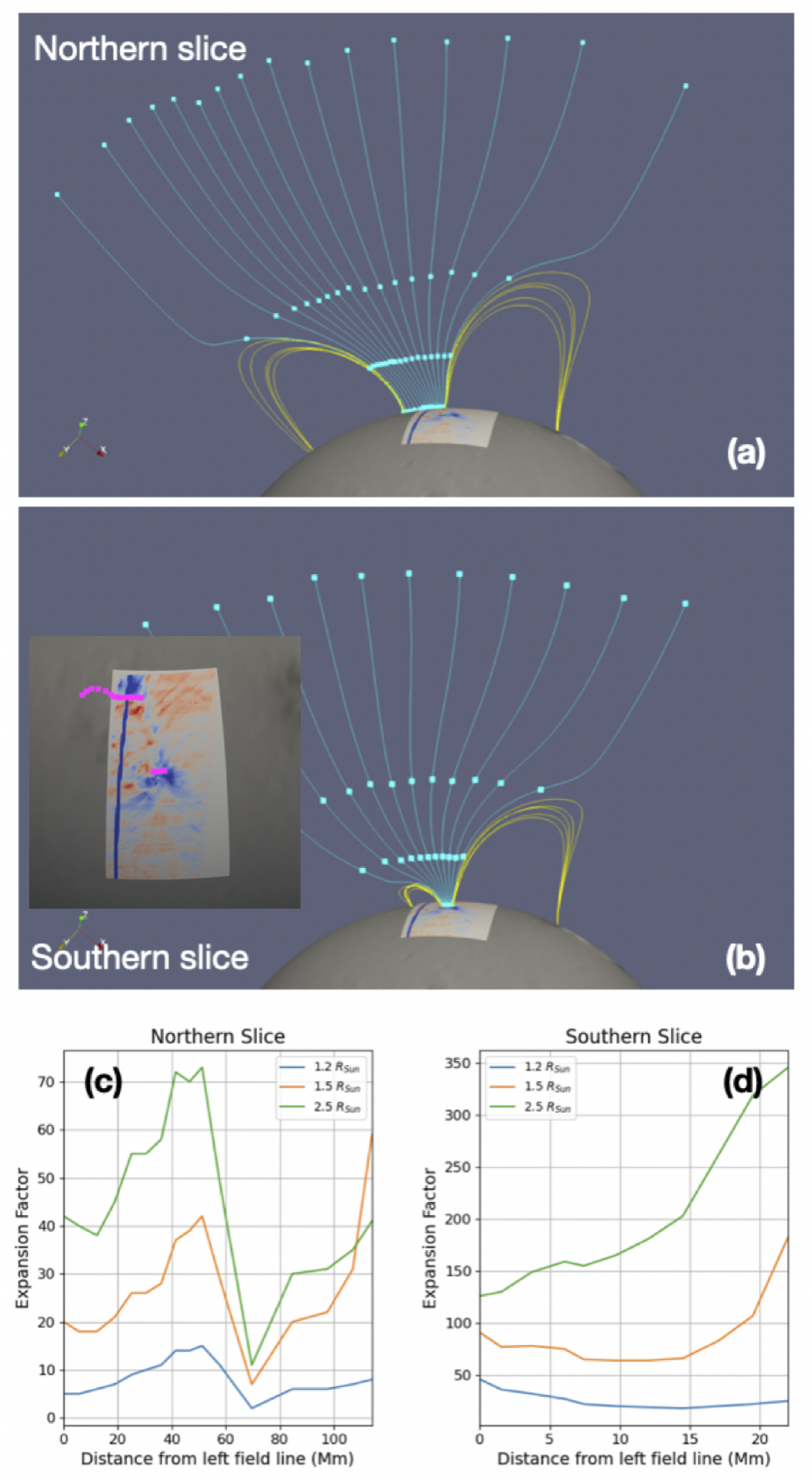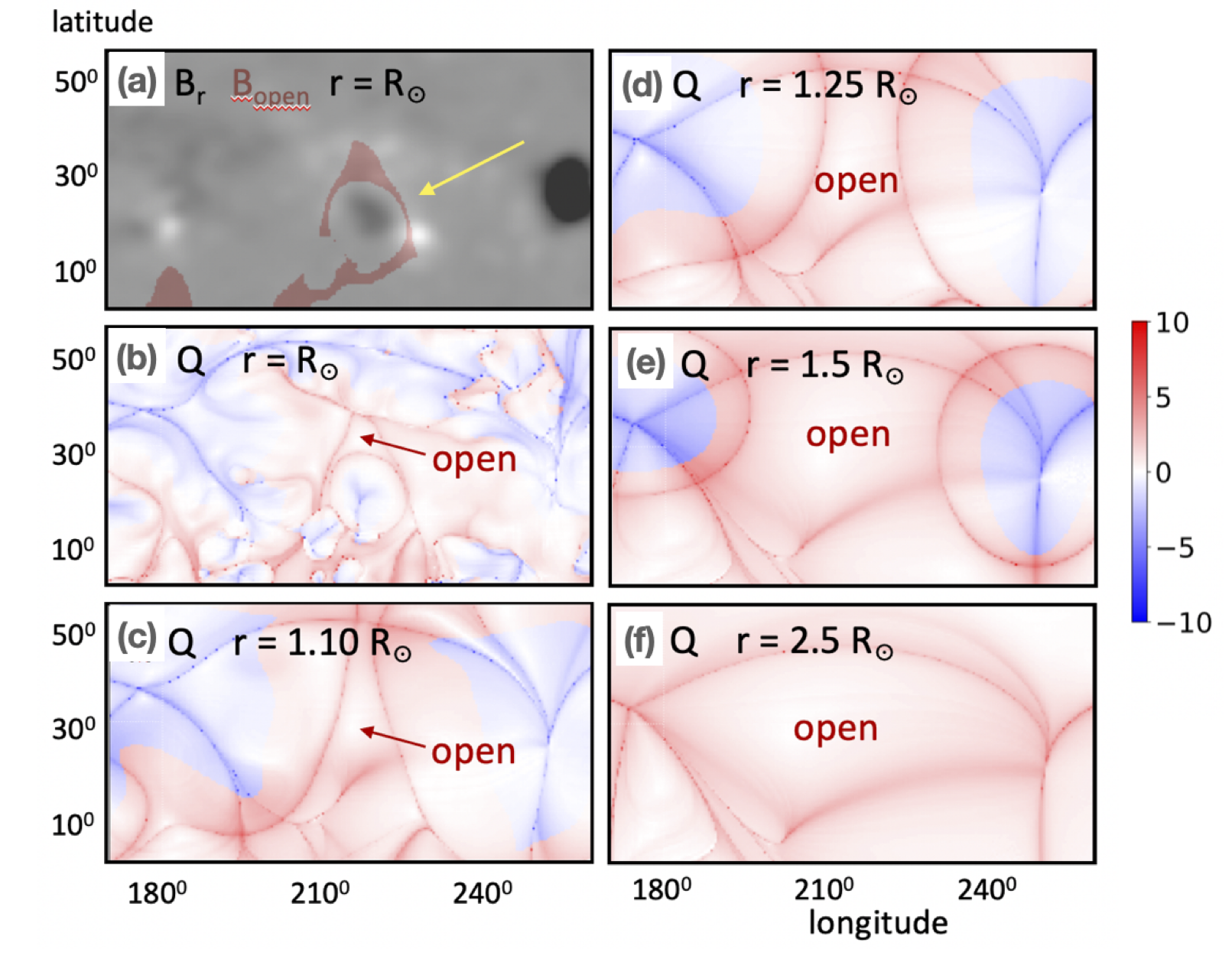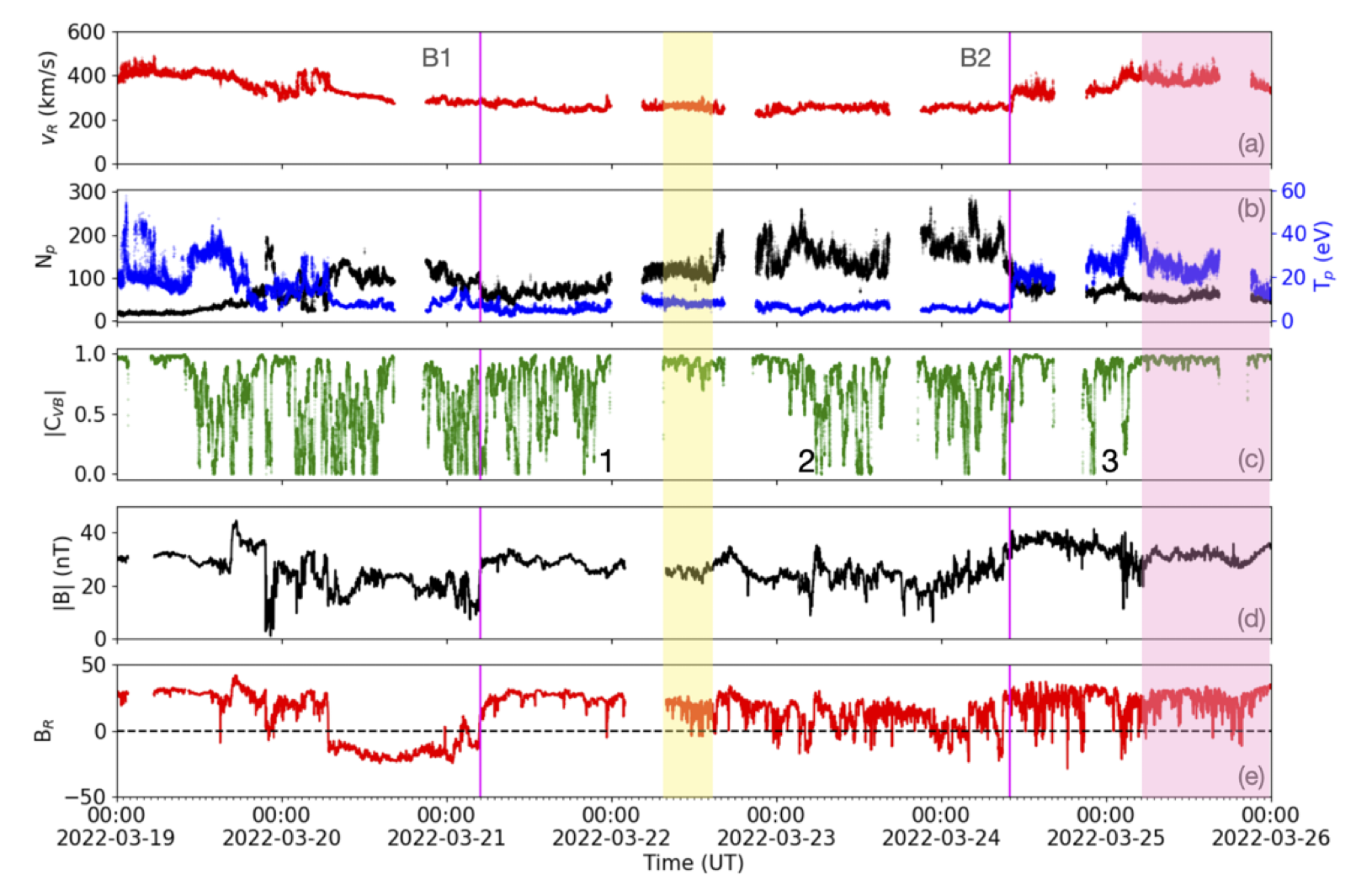Science nugget: Observational Evidence of S-web Source of Slow Solar Wind - Solar Orbiter
Observational Evidence of S-web Source of Slow Solar Wind
(Solar Orbiter nugget #11 by D. Baker1, S. Yardley2,1,3, D. H. Brooks4 and R. D'Amicis5)
Introduction
The solar corona continuously expands outward as hot, magnetized streams of plasma that fill the heliosphere. These streams are classified as the fast and slow solar wind (SW) based on a velocity threshold of 500 km/s. Though the origin and characteristics of the fast SW are well-known, this is not the case with the slow SW. The sources of the slow SW are found in the closed field regions on the Sun, e.g. active regions, coronal hole boundaries (CHB), streamers e.g. [1]. The highly variable nature of the plasma suggests that the slow SW is released onto open field lines by stochastic processes such as magnetic reconnection.
The S-web model proposed by Antiochos et al. [2] provides a theoretical framework for the origin of the slow SW. According to this model, the corona is filled with a network of narrow open field corridors bounded by a web of separatrix surfaces or quasi-separatrix layers (QSLs, [3]). The topology of the S-web consists of giant arcs of open–closed magnetic flux boundary layers extending 10s of degrees in longitude [4,5]. Interchange reconnection is proposed as the mechanism responsible for the release of the slow SW at the S-web arcs.
Characterization of S-web Source Region Observed at Solar Orbiter, SDO and Hinode/EIS
From 18-21 March 2022, active region AR 12967 was tracked simultaneously by Solar Orbiter [6] at 0.35 au and Hinode/EIS at Earth [7].
During this period, strong blue-shifted plasma upflows were observed along a thin, dark corridor of open field originating at the active region's leading polarity and running to the southern extension of the northern polar coronal hole.
Figure 1 contains an SDO/AIA [8] 193 A image and the corresponding EIS Fe XII 195.12 A Doppler velocity map of AR 12967 and the dark corridor.

Figure 1: SDO/AIA 193\AA\, image (left) of AR 12967 and Hinode/EIS Fe XII 195.12 A, Doppler velocity map (right). The corridor of upflows is magnetically connected to Solar Orbiter.
From N-S, plasma and magnetic parameters measured along the corridor become closer to those found at the edges of actives regions rather than coronal holes, e.g. stronger Doppler and nonthermal velocities, stronger magnetic flux density, and higher ratio of coronal to photospheric abundances (FIP bias) of 2.
Magnetic Field Topology of S-Web Source Region
A PFSS extrapolation of AR 12967 shows that the open field lines of the corridor are bordered on either side by closed loops (Figure 2a,b).

Figure 2: Field lines from a PFSS extrapolation along slices orthogonal to the narrow S-web corridor in the north (a) and south (b). Blue/yellow field lines represent open/closed field. Plots of expansion factors along the slices vs. distance from the left in Mm between the footpoints of the field lines (c,d).
The open field extends nearly radially in the center of the corridor and then diverges away from the radial direction closer to the edges where the closed loops are located. At the corridor edges, the open field expands rapidly when the top of the lateral closed field is reached. Expansion factors change along the corridor with an extreme in field line asymmetry reached along the southern slice where the expansion factors are an order of magnitude greater (Figure 2c,d).
The open flux corridor is bordered by a drastic change in magnetic connectivity with field lines changing from reaching the source surface (=2.5 RSUN) to reaching back to the photosphere as closed field. Such a magnetic configuration is typical of quasi-separatrix layers (QSLs). A convenient way to identify strong QSLs is by using the squashing factor, Q, which quantifies how drastic the change of field-line linkage is between two regions [9].
Open positive field encompasses the negative polarity of AR 12967 (Figure 3a). In the Q maps, the corridor broadens strongly with height (Figure 3 b--f). At the source surface, its longitudinal extension is about 60 deg. This is suggestive of the S-web source of the slow SW [2].

Figure 3: Zoomed synoptic magnetogram showing photospheric footpoints of open field (a) and Q-maps at heights from RSUN to 2.5 RSUN (b-f). Yellow arrow indicates location of corridor.
Characterizing the Slow Solar Wind Emanating from S-web Source Region
The magnetic connectivity tool [10] was used to connect the in situ measurements of Solar Orbiter to the open-field corridor of AR 12967. The sharp transitions observed in the in situ parameters provide for the clear-cut boundaries of this interval of connectivity to the corridor (pink vertical lines B1 and B2 in Figure 4). The slow SW stream in the B1--B2 interval has ~300 km/s velocities, low proton temperatures of ~5 eV, extremely high density > 100 cm-3, and a short interval of moderate Alfvénicity (yellow shaded region in Figure 4) accompanied by switchback events.

Figure 4: SWA-PAS (a,b) and MAG (d,e) in situ data: (a) proton velocity VR in red, (b) proton number density Np in black and proton temperature T in blue, (c) absolute value of correlation coefficient Cvb in green, (d) total magnetic field B, and (e) radial magnetic field component BR in red. The pink vertical lines B1 and B2 denote the start and end of the interval of connectivity with the narrow corridor. Shaded areas indicate periods of Alfvénicity. Times are at the spacecraft which is between 1.5 and 2.25 days later than at Sun times. Numbers indicate the inverted U-shaped Alfvénicity pattern.
The Alfvénicity level has several inverted U-shape patterns (labeled as 1,2,3 in the Cvb plot of Figure 4c). Inverted U-shape patterns are consistent with Solar Orbiter changing connectivity from the CH-like field on the western side of AR 12967 negative polarity to the CH-like field on the eastern side. The central part of the corridors has a lower expansion factor and is associated with Cvb close to 1. These inverted U-shape patterns are an important marker of the magnetic field differential expansion across open field regions, i.e. of individual open fields in the low corona where they are spatially separated.
The key properties of the narrow corridor and its associated very slow SW are more extreme than those of equatorial CHs [11] . In particular, the longitudinal width of the corridor in the 1.5 MK corona is up to 2 orders of magnitude smaller, the expansion factors are as much as an order of magnitude larger in the south, and the SW velocities are lower by ~100 km/s. Alfvénicity reaches higher levels compared to the equatorial CHs in their study, however, the period of Alfvénicity is shorter. The extremely high expansion factor related to this short period of Alfvénicity is expected as there is low expansion only in the center of the flux tube compared to the edges. Closer to the edges, the field becomes more curved so that more of the Alfvén waves are reflected back rather than traveling outward along the open field.
Conclusion
The narrow corridor observed by Hinode/EIS and Solar Orbiter has key features predicted by the S-web model -- it is a few orders of magnitude thinner in the longitudinal direction compared to typical equatorial CHs; the corridor is conjectured to be topologically robust [12, 2] and it was observed to be highly stable for at least seven days; the corridor expands to a latitudinal width of 60 deg at the source surface. Some of the extreme properties of the slow SW stream observed by SO are a direct consequence of the very nature of the S-web comprising open field corridor source regions. Extremely narrow corridors are characterized by super-radial expansion and therefore very slow wind velocities. Following on from this, Alfvenic slow SW is associated with over-expanded flux tubes [13, 14, 15]. Large variability in BR and occasional reversal events, i.e. switchbacks, occurred while the very slow SW was moderately Alfvénic. It is therefore plausible that the induced interchange reconnection events along the S-web arcs are a possible source of the switchbacks everpresent in the inner heliosphere and observed in the Alfvénic very slow SW emanating from the narrow open field corridor.
The corridor associated with AR 12967 is not rare. There is a spectrum of widths, mainly as a consequence of the BR distribution in the photosphere and the narrowest of corridors will be beyond the spatial resolution of the magnetic models used to determine the open field regions. In conclusion, the combination of observations from Solar Orbiter and Hinode/EIS has made it possible to characterize the S-web narrow open field corridor source region and its slow SW stream.
The intrinsic topology of the corridors means that super-radial expansion of the open field is likely to yield extremely slow SW velocities, with moderate Alfvénic content (along the central section of the corridor), and switchbacks. Other SW properties such as composition, charge state, and density are more likely to be governed by the surroundings of the corridors as interchange reconnection at the corridor boundaries opens up pathways for closed-field plasma of nearby quiet Sun and active regions to reach the heliosphere.
This works has been published in Baker et al. ApJ, 950:65, 2023 June 10
Affiliations
[1] University College London, Mullard Space Science Laboratory, Holmbury St. Mary, Dorking, Surrey, RH5 6NT, UK
[2] Department of Meteorology, University of Reading, Reading, UK
[3] Donostia International Physics Center (DIPC), Paseo Manuel de Lardizabal 4, 20018 San Sebastián, Spain
[4] College of Science, George Mason University, 4400 University Drive, Fairfax, VA 22030, USA
[5] National Institute for Astrophysics, Institute for Space Astrophysics and Planetology, Rome, Italy
References
[1] Abbo et al. 2016, SSRv, 201:55
[2] Antiochos et al. 2011, ApJ, 731:112
[3] Démoulin et al. 1996, A&A, 308:643
[4] Higginson et al. 2017, ApJL, 840:L10
[5] Scott et al. 2018, ApJ, 869:60
[6] Müller et al. 2020, A&A, 642:A1
[7] Culhane et al. 2007, SoPh, 243:19
[8] Pesnell et al. 2012, 275:3
[10] Rouillard et al. 2020, A&A, 642, A2
[11] Wang & Ko 2019
[12] Antiochos et al. 2011, ApJ, 731:112
[13] Bale et al. 2019, Nature, 576:237
[14] D’Amicis et al. 2021, JGR, 126, 28996
[15] Fedorov et al. 2021, A&A, 656: A40
- Removed a total of (4) style margin:0;
Nuggets archive
2025
09/04/2025: Bursty acceleration and 3D trajectories of electrons in a solar flare
02/04/2025: Picoflare jets in the coronal holes and their link to the solar wind
19/03/2025: Radial dependence of solar energetic particle peak fluxes and fluences
12/03/2025: Analysis of solar eruptions deflecting in the low corona
05/03/2025: Propagation of particles inside a magnetic cloud: Solar Orbiter insights
19/02/2025: Rotation motions and signatures of the Alfvén waves in a fan-spine topology
12/02/2025: 'Sun'day everyday: 2 years of Solar Orbiter science nuggets that shed light on some of our star's mysteries
22/01/2025: Velocity field in the solar granulation from two-vantage points
15/01/2025: First joint X-ray solar microflare observations with NuSTAR and Solar Orbiter/STIX
2024
18/12/2024: Shocks in tandem : Solar Orbiter observes a fully formed forward-reverse shock pair in the inner heliosphere
11/12/2024: High-energy insights from an escaping coronal mass ejection
04/12/2024: Investigation of Venus plasma tail using the Solar Orbiter, Parker Solar Probe and Bepi Colombo flybys
27/11/2024: Testing the Flux Expansion Factor – Solar Wind Speed Relation with Solar Orbiter data
20/11/2024:The role of small scale EUV brightenings in the quiet Sun coronal heating
13/11/2024: Improved Insights from the Suprathermal Ion Spectrograph on Solar Orbiter
30/10/2024: Temporally resolved Type III solar radio bursts in the frequency range 3-13 MHz
23/10/2024: Resolving proton and alpha beams for improved understanding of plasma kinetics: SWA-PAS observations
25/09/2024: All microflares that accelerate electrons to high-energies are rooted in sunspots
25/09/2024: Connecting Solar Orbiter and L1 measurements of mesoscale solar wind structures to their coronal source using the Adapt-WSA model
18/09/2024: Modelling the global structure of a coronal mass ejection observed by Solar Orbiter and Parker Solar Probe
28/08/2024: Coordinated observations with the Swedish 1m Solar Telescope and Solar Orbiter
21/08/2024: Multi-source connectivity drives heliospheric solar wind variability
14/08/2024: Composition Mosaics from March 2022
19/06/2024: Coordinated Coronal and Heliospheric Observations During the 2024 Total Solar Eclipse
22/05/2024: Real time space weather prediction with Solar Orbiter
15/05/2024: Hard X ray and microwave pulsations: a signature of the flare energy release process
01/02/2024: Relativistic electrons accelerated by an interplanetary shock wave
11/01/2024: Modelling Two Consecutive Energetic Storm Particle Events observed by Solar Orbiter
2023
14/12/2023: Understanding STIX hard X-ray source motions using field extrapolations
16/11/2023: EUI data reveal a "steady" mode of coronal heating
09/11/2023: A new solution to the ambiguity problem
02/11/2023: Solar Orbiter and Parker Solar Probe jointly take a step forward in understanding coronal heating
25/10/2023: Observations of mini coronal dimmings caused by small-scale eruptions in the quiet Sun
18/10/2023: Fleeting small-scale surface magnetic fields build the quiet-Sun corona
27/09/2023: Solar Orbiter reveals non-field-aligned solar wind proton beams and its role in wave growth activities
20/09/2023: Polarisation of decayless kink oscillations of solar coronal loops
23/08/2023: A sharp EUI and SPICE look into the EUV variability and fine-scale structure associated with coronal rain
02/08/2023: Solar Flare Hard Xrays from the anchor points of an eruptive filament
28/06/2023: 3He-rich solar energetic particle events observed close to the Sun on Solar Orbiter
14/06/2023: Observational Evidence of S-web Source of Slow Solar Wind
31/05/2023: An interesting interplanetary shock
24/05/2023: High-resolution imaging of coronal mass ejections from SoloHI
17/05/2023: Direct assessment of far-side helioseismology using SO/PHI magnetograms
10/05/2023: Measuring the nascent solar wind outflow velocities via the doppler dimming technique
26/04/2023: Imaging and spectroscopic observations of EUV brightenings using SPICE and EUI on board Solar Orbiter
19/04/2023: Hot X-ray onset observations in solar flares with Solar Orbiter/STIX
12/04/2023: Multi-scale structure and composition of ICME prominence material from the Solar Wind Analyser suite
22/03/2023: Langmuir waves associated with magnetic holes in the solar wind
15/03/2023: Radial dependence of the peak intensity of solar energetic electron events in the inner heliosphere
08/03/2023: New insights about EUV brightenings in the quiet sun corona from the Extreme Ultraviolet Imager








































 Sign in
Sign in
 Science & Technology
Science & Technology